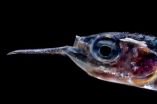(Press-News.org) SAN ANTONIO (Feb. 6, 2014) — Scientists from the School of Medicine at The University of Texas Health Science Center at San Antonio have found a clue as to why muscles weaken with age. In a study published Feb. 5 in The Journal of Neuroscience, they report the first evidence that "set points" in the nervous system are not inalterably determined during development but instead can be reset with age. They observed a change in set point that resulted in significantly diminished motor function in aging fruit flies.
"The body has a set point for temperature (98.6 degrees), a set point for salt level in the blood, and other homeostatic (steady-state) set points that are important for maintaining stable functions throughout life," said study senior author Ben Eaton, Ph.D., assistant professor of physiology at the Health Science Center. "Evidence also points to the existence of set points in the nervous system, but it has never been observed that they change, until now."
VIDEO:
Researchers at The University of Texas Health Science Center at San Antonio recorded changes in the neuromuscular junction synapses of aging fruit flies. These synapses are spaces where neurons exchange...
Click here for more information.
A new set point in older flies
Dr. Eaton and lead author Rebekah Mahoney, a graduate student, recorded changes in the neuromuscular junction synapses of aging fruit flies. These synapses are spaces where neurons exchange electrical signals to enable motor functions such as walking and smiling. "We observed a change in the synapse, indicating that the homeostatic mechanism had adjusted to maintain a new set point in the older animal," Mahoney said.
The change was nearly 200 percent, and the researchers predicted that it would leave muscles more vulnerable to exhaustion.
Potential risk of neurodegeneration
Aside from impairing movement in aging animals, a new functional set point in neuromuscular junctions could put the synapse at risk for developing neurodegeneration — the hallmark of disorders such as Alzheimer's and Parkinson's diseases, Mahoney said.
VIDEO:
Researchers at The University of Texas Health Science Center at San Antonio recorded changes in the neuromuscular junction synapses of aging fruit flies. These synapses are spaces where neurons exchange...
Click here for more information.
"Observing a change in the set point in synapses alters our paradigms about how we think age affects the function of the nervous system," she said.
It appears that a similar change could lead to effects on learning and memory in old age. An understanding of this phenomenon would be invaluable and could lead to development of novel therapies for those issues, as well.
INFORMATION:
Joel Rawson, Ph.D., of the University of Alaska at Anchorage, formerly a postdoctoral fellow in Dr. Eaton's lab, is a study co-author.
For current news from the UT Health Science Center San Antonio, please visit our news release website, like us on Facebook or follow us on Twitter.
The University of Texas Health Science Center at San Antonio, one of the country's leading health sciences universities, ranks in the top 3 percent of all institutions worldwide receiving National Institutes of Health funding. The university's schools of medicine, nursing, dentistry, health professions and graduate biomedical sciences have produced more than 29,000 graduates. The $765 million operating budget supports eight campuses in San Antonio, Laredo, Harlingen and Edinburg. For more information on the many ways "We make lives better®," visit http://www.uthscsa.edu.
Finding could explain age-related decline in motor function
Team sees change in set point in neuromuscular synapses
2014-02-07
ELSE PRESS RELEASES FROM THIS DATE:
Gender influences symptoms of genetic disorder
2014-02-07
A genetic disorder that affects about 1 in every 2,500 births can cause a bewildering array of clinical problems, including brain tumors, impaired vision, learning disabilities, behavioral problems, heart defects and bone deformities. The symptoms and their severity vary among patients affected by this condition, known as neurofibromatosis type 1 (NF1).
Now, researchers at Washington University School of Medicine in St. Louis have identified a patient's gender as a clear and simple guidepost to help health-care providers anticipate some of the effects of NF1. The scientists ...
The fatality rate among hard drug users is 14 times higher than for the general population
2014-02-07
A new study analyses the risk factors and excess mortality among heroin and cocaine consumers admitted to treatment in Spain. The results reveal that the fatality rate among consumers of both drugs is 14.3 times higher than for the general population, while among those only using cocaine, it is 5.1 times higher.
In Spain the majority of deaths related to cocaine are not correctly certified and therefore up until now very few studies have been carried out that analyse the consequences of consuming these drugs in terms of mortality.
"Death certificates rarely include ...
Smithsonian reports GMO soybean pollen threatens Mexican honey sales
2014-02-07
Mexico is the fourth largest honey producer and fifth largest honey exporter in the world. A Smithsonian researcher and colleagues helped rural farmers in Mexico to quantify the genetically modified organism (GMO) soybean pollen in honey samples rejected for sale in Germany. Their results will appear Feb. 7 in the online journal, Scientific Reports.
David Roubik, senior staff scientist at the Smithsonian Tropical Research Institute, and colleagues developed the ability to identify pollen grains in honey in Panama and in Mexico during the 1980s and 1990s when they studied ...
Fish biomass in the ocean is 10 times higher than estimated
2014-02-07
With a stock estimated at 1,000 million tons so far, mesopelagic fish dominate the total biomass of fish in the ocean. However, a team of researchers with the participation of the Spanish National Research Council (CSIC) has found that their abundance could be at least 10 times higher. The results, published in Nature Communications journal, are based on the acoustic observations conducted during the circumnavigation of the Malaspina Expedition.
Mesopelagic fishes, such as lantern fishes (Myctophidae) and cyclothonids (Gonostomatidae), live in the twilight zone of the ...
'Steak-knife' teeth reveal ecology of oldest land predators
2014-02-07
The first top predators to walk on land were not afraid to bite off more than they could chew, a University of Toronto Mississauga study has found.
Graduate student and lead author Kirstin Brink along with Professor Robert Reisz from U of T Mississauga's Department of Biology suggest that Dimetrodon, a carnivore that walked on land between 298 million and 272 million years ago, was the first terrestrial vertebrate to develop serrated ziphodont teeth.
According to the study published in Nature Communications, ziphodont teeth, with their serrated edges, produced a more-efficient ...
Study reveals record rise in insulin use
2014-02-07
"Understanding the pattern of insulin use is limited by a lack of data characterising the prevalence of insulin use in the UK," according to Craig Currie, Professor of Applied Pharmacoepidemiology at Cardiff University's School of Medicine, who led the study alongside colleagues from the University of Bristol.
"Given the limitations, our study sought to calculate – for the first time – the best possible estimate of the rates of insulin for type 1 and type 2 diabetes."
In this retrospective study the team examined the number of patients receiving prescriptions for ...
Rett syndrome genetic variants now available for advance testing, diagnosis & research
2014-02-07
Philadelphia, PA, February 7, 2014 – Despite the identification of gene mutations in methyl CpG binding protein 2 (MECP2) being linked to Rett syndrome (RS), research has been hindered by the lack of commercially available reference materials. Through collaboration between the Centers for Disease Control and Prevention (CDC) and members of the clinical-laboratory and non-profit–research communities, 35 DNA samples containing many common RS genetic variants have now been characterized and made publicly available, eliminating a major stumbling-block for investigators and ...
New guidelines for reducing stroke risks unique to women
2014-02-06
For the first time, guidelines have been developed for preventing stroke in women.
"If you are a woman, you share many of the same risk factors for stroke with men, but your risk is also influenced by hormones, reproductive health, pregnancy, childbirth and other sex-related factors," said Cheryl Bushnell, M.D., M.H.S., author of the new scientific statement published in the American Heart Association journal Stroke.
The guidelines outline stroke risks unique to women and provide scientifically-based recommendations on how best to treat them, including:
Women with a ...
Cholesterol plays a critical role in hantavirus infection
2014-02-06
Viruses mutate fast, which means they can quickly become resistant to anti-viral drugs. But viruses also depend on proteins and nutrients provided by their hosts, and therefore one strategy to identify new anti-viral drugs is to identify and target such host-cell components. A paper published on February 6th in PLOS Pathogens reports that proteins involved in the regulation of cholesterol are essential for hantavirus entry into human host cells.
There are only about 30 known human cases of hantavirus infection in the US per year (with the 2012 cluster in Yosemite National ...
Toxin in seafood causes kidney damage in mice at levels considered safe for consumption
2014-02-06
Washington, DC (February 6, 2014) — A chemical that can accumulate in seafood and is known to cause brain damage is also toxic to the kidneys, but at much lower concentrations. The findings, which come from a study appearing in an upcoming issue of the Journal of the American Society of Nephrology (JASN), suggest that officials may need to reconsider what levels of the toxin are safe for human consumption.
The world's oceans contain algae that produce certain chemicals that can be harmful to humans and other living creatures. Many of these chemicals are considered neurotoxins ...
LAST 30 PRESS RELEASES:
Making lighter work of calculating fluid and heat flow
Normalizing blood sugar can halve heart attack risk
Lowering blood sugar cuts heart attack risk in people with prediabetes
Study links genetic variants to risk of blinding eye disease in premature infants
Non-opioid ‘pain sponge’ therapy halts cartilage degeneration and relieves chronic pain
AI can pick up cultural values by mimicking how kids learn
China’s ecological redlines offer fast track to 30 x 30 global conservation goal
Invisible indoor threats: emerging household contaminants and their growing risks to human health
Adding antibody treatment to chemo boosts outcomes for children with rare cancer
Germline pathogenic variants among women without a history of breast cancer
Tanning beds triple melanoma risk, potentially causing broad DNA damage
Unique bond identified as key to viral infection speed
Indoor tanning makes youthful skin much older on a genetic level
Mouse model sheds new light on the causes and potential solutions to human GI problems linked to muscular dystrophy
The Journal of Nuclear Medicine ahead-of-print tip sheet: December 12, 2025
Smarter tools for peering into the microscopic world
Applications open for funding to conduct research in the Kinsey Institute archives
Global measure underestimates the severity of food insecurity
Child survivors of critical illness are missing out on timely follow up care
Risk-based vs annual breast cancer screening / the WISDOM randomized clinical trial
University of Toronto launches Electric Vehicle Innovation Ontario to accelerate advanced EV technologies and build Canada’s innovation advantage
Early relapse predicts poor outcomes in aggressive blood cancer
American College of Lifestyle Medicine applauds two CMS models aligned with lifestyle medicine practice and reimbursement
Clinical trial finds cannabis use not a barrier to quitting nicotine vaping
Supplemental nutrition assistance program policies and food insecurity
Switching immune cells to “night mode” could limit damage after a heart attack, study suggests
URI-based Global RIghts Project report spotlights continued troubling trends in worldwide inhumane treatment
Neutrophils are less aggressive at night, explaining why nighttime heart attacks cause less damage than daytime events
Menopausal hormone therapy may not pose breast cancer risk for women with BRCA mutations
Mobile health tool may improve quality of life for adolescent and young adult breast cancer survivors
[Press-News.org] Finding could explain age-related decline in motor functionTeam sees change in set point in neuromuscular synapses





